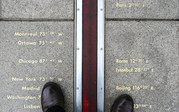Everyday Time and Atomic Time: Part 5 By Judah Levine, a physicist at NIST and a professor at the University of Colorado Boulder When atomic clocks were developed in the 1950s, scientists needed to match the time and frequency of these new devices to the long-standing astronomical definitions of these same parameters in order to enable a smooth, continuous transition from astronomical to atomic time. The transition between astronomical time and atomic time was based on measurements made over a three-year period from 1955 to 1958. The measurements were a joint effort of William Markowitz at the U.S. Naval Observatory in Washington, D.C., and Louis Essen and Jack Parry at the National Physical Laboratory in the U.K. The length of the second based on the frequency of the atomic clock that was derived from these measurements was somewhat shorter than the astronomical second, so that clocks that used the atomic-clock frequency were fast with respect to astronomical time by about one second per year. | 




No comments:
Post a Comment